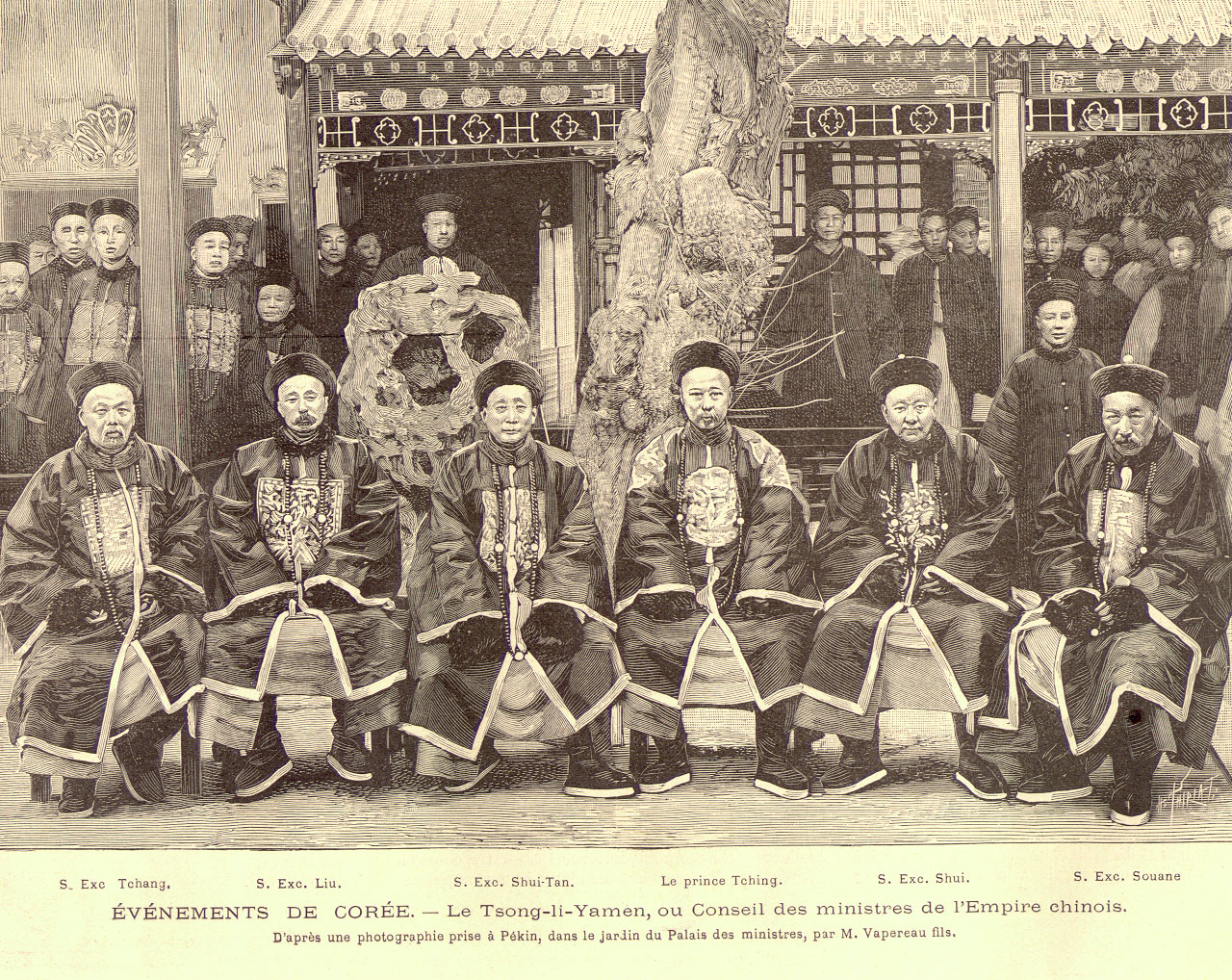|
Nagasaki Incident
The , also known as the Nagasaki―Qing Navy Incident (長崎清国水兵事件) was an incident took place on August 13, 1886 (the twelfth year of the reign of Emperor Guangxu Emperor, Guangxu of the Qing Dynasty) during the Beiyang Fleet visit to Nagasaki, Japan. Some Chinese sailors violated military discipline when they went ashore for shopping, went to local brothels and drank and made troubles. As a result, they clashed with the Japanese police. A Japanese policeman was stabbed and seriously injured, and a Chinese sailor was slightly injured. In February 1887, the two sides reached an agreement under the mediation of the British Empire, British and German Empire, German ministers. Both parties compensated the dead and injured persons of the other party. Outline On 1 August 1886 (Meiji period, Meiji 19), the Qing dynasty's Beiyang Fleet, consisting of four warships, the Chinese turret ship Dingyuan, ''Dingyuan'', the Chinese turret ship Zhenyuan, ''Zhenyuan'', the Chinese ... [...More Info...] [...Related Items...] OR: [Wikipedia] [Google] [Baidu] [Amazon] |
Nagasaki
, officially , is the capital and the largest Cities of Japan, city of Nagasaki Prefecture on the island of Kyushu in Japan. Founded by the Portuguese, the port of Portuguese_Nagasaki, Nagasaki became the sole Nanban trade, port used for trade with the Portuguese and Dutch during the 16th through 19th centuries. The Hidden Christian Sites in the Nagasaki Region have been recognized and included in the World Heritage Sites in Japan, UNESCO World Heritage Sites list. Part of Nagasaki was home to a major Imperial Japanese Navy base during the First Sino-Japanese War and Russo-Japanese War. Near the end of World War II, the American atomic bombings of Hiroshima and Nagasaki made Nagasaki the second city in the world to experience a nuclear attack. The city was rebuilt. , Nagasaki has an estimated population of 392,281, and a population density of 966 people per km2. The total area is . History Nagasaki as a Jesuit port of call The first recorded contact between Portuguese e ... [...More Info...] [...Related Items...] OR: [Wikipedia] [Google] [Baidu] [Amazon] |
Gapsin Coup
The Kapsin Coup, also known as the Kapsin Revolution, was a failed three-day coup d'état that occurred in Korea during 1884. Korean reformers in the Enlightenment Party sought to initiate rapid changes within the country, including eliminating social distinctions by abolishing the legal privileges of the yangban class. The coup d'état attempt, with Japanese support, began on December 4, 1884, with seizure of the royal palace Changdeokgung in Seoul and the killing of several members of the pro-Chinese conservative faction. However, the coup was eventually suppressed by a Chinese garrison stationed in the country. Thwarted by the Chinese actions, some of the pro-Japanese faction leaders found exile in Japan. The event led to informal Chinese domination of Korea from 1885 to 1894. Within the Joseon court, Chinese influence grew particularly under the Resident-General Yuan Shikai. Background After the Imo Incident of 1882, early reform efforts in Korea suffered a major setback ... [...More Info...] [...Related Items...] OR: [Wikipedia] [Google] [Baidu] [Amazon] |
1886 Riots
Events January * January 1 – Upper Burma is formally annexed to British Burma, following its conquest in the Third Anglo-Burmese War of November 1885. * January 5– 9 – Robert Louis Stevenson's novella ''Strange Case of Dr Jekyll and Mr Hyde'' is published in New York and London. * January 16 – A resolution is passed in the German Parliament to condemn the Prussian deportations, the politically motivated mass expulsion of ethnic Poles and Jews from Prussia, initiated by Otto von Bismarck. * January 18 – Modern field hockey is born with the formation of The Hockey Association in England. * January 29 – Karl Benz patents the first successful gasoline-driven automobile, the Benz Patent-Motorwagen (built in 1885). February * February 6– 9 – Seattle riot of 1886: Anti-Chinese sentiments result in riots in Seattle, Washington. * February 8 – The West End Riots following a popular meeting in Trafalgar Square, London. * February ... [...More Info...] [...Related Items...] OR: [Wikipedia] [Google] [Baidu] [Amazon] |
1886 In International Relations
Events January * January 1 – Upper Burma is formally annexed to British rule in Burma, British Burma, following its conquest in the Third Anglo-Burmese War of November 1885. * January 5–January 9, 9 – Robert Louis Stevenson's novella ''Strange Case of Dr Jekyll and Mr Hyde'' is published in New York and London. * January 16 – A resolution is passed in the German Parliament to condemn the Prussian deportations, the politically motivated mass expulsion of ethnic Poles and Jews from Prussia, initiated by Otto von Bismarck. * January 18 – Modern field hockey is born with the formation of The Hockey Association in England. * January 29 – Karl Benz patents the first successful gasoline-driven automobile, the Benz Patent-Motorwagen (built in 1885). February * February 6–February 9, 9 – Seattle riot of 1886: Anti-Chinese sentiments result in riots in Seattle, Washington. * February 8 – The West End Riots following a popular meetin ... [...More Info...] [...Related Items...] OR: [Wikipedia] [Google] [Baidu] [Amazon] |
1886 In Japan
Events in the year 1886 in Japan. It corresponds to Meiji period, Meiji 19 (明治19年) in the Japanese calendar. Incumbents *Monarchy of Japan, Monarch: Emperor Meiji *Prime Minister of Japan, Prime Minister: Itō Hirobumi Governors *List of governors of Aichi Prefecture, Aichi Prefecture: Minoru Katsumata *Akita Prefecture: Akagawa then Sada Aoyama *List of governors of Aomori Prefecture, Aomori Prefecture: Kyusei Fukushima then Nabeshima Miki *Ehime Prefecture: Shinpei Seki *Fukui Prefecture: Tsutomu Ishiguro *Fukuoka Prefecture: Yasujo *Fukushima Prefecture: Kinichi Akashi then Hiraochi Orita *Gifu Prefecture: Toshi Kozaki *Gunma Prefecture: Katori Yoshihiko *Governors of Hiroshima Prefecture, Hiroshima Prefecture: Senda Sadaaki *List of governors of Ibaraki Prefecture, Ibaraki Prefecture: Shima then Sadanori Yasuda *Iwate Prefecture: Shoichiro Ishii *List of governors of Kanagawa Prefecture, Kanagawa Prefecture: Baron Tadatsu Hayashi *Kochi Prefecture: Yoshiaki Tonabe *Lis ... [...More Info...] [...Related Items...] OR: [Wikipedia] [Google] [Baidu] [Amazon] |
1886 In China
Events in the year 1886 in China. Incumbents *Emperor: Guangxu Emperor (12th year) Viceroys * Viceroy of Zhili — Li Hongzhang * Viceroy of Min-Zhe — Yang Changjun * Viceroy of Huguang — Yulu * Viceroy of Shaan-Gan — Tan Zhonglin * Viceroy of Liangguang — Zhang Zhidong * Viceroy of Yun-Gui — Cen Yuying * Viceroy of Sichuan — Ding Baozhen then Liu Bingzhang * Viceroy of Liangjiang — Zeng Guoquan Births *March 5 — Dong Biwu, 2nd Vice President of China (d. 1975) *March 20 — Lin Boqu, politician and poet (d. 1960) *September 28 — Tan Pingshan, early member of the Chinese Communist Party (d. 1956) *October 11 — Shao Piaoping, journalist, author and political activist (d. 1926) *December 1 — Zhu De, 2nd Chairman of the Standing Committee of the National People's Congress (d. 1976) *December 9 — Zhang Dongsun, philosopher, public intellectual and political figure (d. 1973) Dates unknown * Fang Shengdong, revolutionary figure (d. 1911)Lee, L.X. ... [...More Info...] [...Related Items...] OR: [Wikipedia] [Google] [Baidu] [Amazon] |
Zongli Yamen
The ''Zongli Yamen'' (), short for Office for the General Management of Affairs Concerning the Various Countries (), also known as Prime Minister's Office, Office of General Management, was the government body in charge of foreign policy in imperial China during the late Qing dynasty. It was established by Prince Gong on 11 March 1861 after the Convention of Beijing. It was abolished by the Qing government in 1901 and replaced with a Foreign Office of ministry rank. The former site of the ''Zongli Yamen'' is now located in Dongtangzi Hutong, Dongcheng District, Beijing. Nearly all the buildings are preserved in good condition. Meaning of name ''Zongli Yamen'' is a traditional abbreviation of the official name (), literally meaning "Office in Charge of Affairs Concerning All Nations".The corresponding name in Manchu, the other official language of the Qing Empire, was ''Geren gurun i baita be uherileme icihiyara yamun.'' () A common misconception is that the Zongli Yamen's n ... [...More Info...] [...Related Items...] OR: [Wikipedia] [Google] [Baidu] [Amazon] |
Japan Telecom
SoftBank Telecom Corporation (), previously as Japan Telecom Co. Ltd. (,Nippon Terekomu Kabushiki-gaisha) was a Japanese telephone company of the SoftBank group. It provides services to businesses and consumers in Japan. It provides long-distance telephone service, international call service, and direct connection fixed-line voice service. In addition, it engages in the billing and collecting fees for the telephony service; consulting, development and establishment of telecommunication system; and provision of information processing and providing service. On 1 April 2015 Softbank Telecom Corp. merged into Softbank Mobile Corp. and ceased to exist as a separate entity. Timeline *1984-10: Japanese Telecom Telegraph was founded. *1986-08: Japanese Telecom Telegraph launches leased circuit services *1986-12: Railway Telecommunication ( JR Telecom, or JR Tsushin) established *1989-05: Railway Telecommunication merges with Japan Telecom *2002-08: Company name was changed to Japan Tel ... [...More Info...] [...Related Items...] OR: [Wikipedia] [Google] [Baidu] [Amazon] |
Mutsu Munemitsu
Count was a Japanese diplomat and politician. He became Minister for Foreign Affairs (Japan), Minister of Foreign Affairs in 1890 and worked to revise unequal treaties. He served as plenipotentiary at the Treaty of Shimonoseki, peace conference in Shimonoseki after the First Sino-Japanese War. Early life Mutsu Munemitsu was born in Kishū Domain, Wakayama domain, Kii Province as the sixth son of Date Munehiro, a ''samurai'' retainer of the Kii Tokugawa Clan. His father was active in the ''Sonnō jōi'' movement, and Mutsu Munemitsu joined forces with Sakamoto Ryōma and Itō Hirobumi in the movement to overthrow the Tokugawa shogunate. Career After the Meiji Restoration, Mutsu held a number of posts in the new Meiji government, including that of governor of Hyōgo Prefecture and later governor of Kanagawa Prefecture, both of which were host to foreign settlements. He was head of the Land Tax Reform of 1873–1881, and served on the ''Genrōin''. He conspired to assist Saigō T ... [...More Info...] [...Related Items...] OR: [Wikipedia] [Google] [Baidu] [Amazon] |
Code Breaking
Cryptanalysis (from the Greek ''kryptós'', "hidden", and ''analýein'', "to analyze") refers to the process of analyzing information systems in order to understand hidden aspects of the systems. Cryptanalysis is used to breach cryptographic security systems and gain access to the contents of encrypted messages, even if the cryptographic key is unknown. In addition to mathematical analysis of cryptographic algorithms, cryptanalysis includes the study of side-channel attacks that do not target weaknesses in the cryptographic algorithms themselves, but instead exploit weaknesses in their implementation. Even though the goal has been the same, the methods and techniques of cryptanalysis have changed drastically through the history of cryptography, adapting to increasing cryptographic complexity, ranging from the pen-and-paper methods of the past, through machines like the British Bombes and Colossus computers at Bletchley Park in World War II, to the mathematically advanced compute ... [...More Info...] [...Related Items...] OR: [Wikipedia] [Google] [Baidu] [Amazon] |
Battle Of Weihaiwei
The Battle of Weihaiwei (Japanese: took place between 20 January and 12 February 1895, during the First Sino-Japanese War in Weihai, Shandong Province, China, between the forces of Japan and Qing China. In early January 1895, the Japanese landed forces in eastern Shandong positioning forces behind the Chinese naval base at Weihaiwei. Through a well-coordinated offensive of both naval and land forces, the Japanese destroyed the forts and sank much of the Chinese fleet. With the Shandong and Liaoning peninsulas under Japanese control, the option for a pincer attack against the Chinese capital, Beijing, was now a possibility. This strategic threat forced the Chinese to sue for peace and led to the war's end in April 1895. Background Following its victory at the Battle of Lushunkou on 21 November 1894, the next strategic objective of the Japanese campaign was to neutralize the Qing naval base at Weihaiwai on Shandong Peninsula. This would give Japan total control over the en ... [...More Info...] [...Related Items...] OR: [Wikipedia] [Google] [Baidu] [Amazon] |






